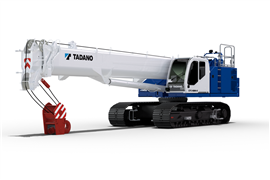Wagenborg installs railway bridges
06 July 2023
Wagenborg Nedlift used Enerpac jack-up technology to lift and install railway and pedestrian bridges at Leverkusen in Germany.
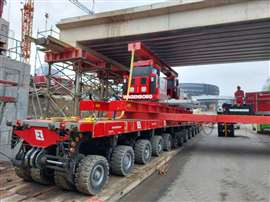 Enerpac JS-250 mounted on a SPMT moves into position to lift the railway bridge. (Photo: Enerpac)
Enerpac JS-250 mounted on a SPMT moves into position to lift the railway bridge. (Photo: Enerpac)
Enerpac JS-250 Jack-Up and SCJ-100 cube jack systems were deployed to complete the bridge deck placements ahead of the laying of new railway track on the Rhine-Ruhr Express line.
The Rhine-Ruhr Express (RRX) route is being upgraded to reduce delays caused by long distance, regional and freight transport sharing the same tracks.
Two bridges
At Leverkusen, the bridge on Rathenaustrasse has been widened to accommodate a new railway line on the Langenfeld/ Leverkusen section.
Wagenborg was tasked with installing two bridges next to the existing bridge: a main track bridge and a pedestrian/ cycle bridge.
Both bridges had to be installed over a weekend without disrupting rail services. The tracks on the existing bridge remained in use throughout the weekend.
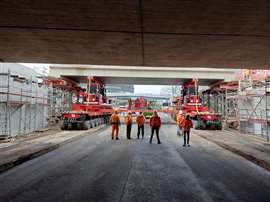 Railway bridge deck ready to be lifted by the JS-250 jack-up system. (Photo: Enerpac)
Railway bridge deck ready to be lifted by the JS-250 jack-up system. (Photo: Enerpac)
Pre-assembly
Pre-assembly of both bridge decks at a height of 4.3 metres was undertaken parallel to the rail line. Wagenborg used a combination of Enerpac jack ups and SPMTs to first move the decks 15 metres and then lower them onto bridge bearings to complete the installations.
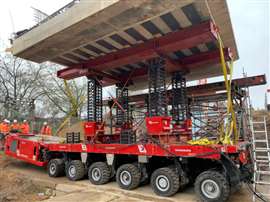 Enerpac SCJ-100 cube jacks on a SPMT transport the passenger bridge into position. (Photo: Enerpac)
Enerpac SCJ-100 cube jacks on a SPMT transport the passenger bridge into position. (Photo: Enerpac)
The railway bridge, weighing 438 tonnes and 21 metres long, was installed first using the JS-250 jack-up system (four lifting towers resting on four SPMTs). The deck was raised to 7 metres, lifting it above the bridge abutments, and lowered into position using the jack- up system.
The 7.5 metre long and 7.1 metre wide pedestrian and cycle bridge weighing 82 tonnes was moved into position using four SCJ-100 cube jacks on a single SPMT.
As the bridge deck was being raised to 5.5 metres, and the cube jacks raised to 2.7 metres, bracing was needed to reduce the effect of sideload. The narrow gap was just wide enough fit the SPMT.
Using the cube jacks to lower the bridge deck was far quicker than using traditional jack and pack, it took just 10 minutes compared with 2 hours.
“We’ve used the JS-250 Jack-Up on many bridge projects, it is a well-proven technique which works well,” said Bart van der Belt, project manager at Wagenborg Nedlift.
“For the pedestrian bridge, we chose the SCJ-100 cube jack because of the proximity of the rail overhead power lines which ruled out using a crane. It too worked very well and was considerably quicker than using jack and pack to lower the bridge deck.”
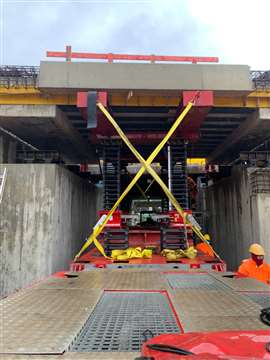 Preparing to lower the passenger bridge using the SCJ-100 cube jacks. (Photo: Enerpac)
Preparing to lower the passenger bridge using the SCJ-100 cube jacks. (Photo: Enerpac)
STAY CONNECTED


Receive the information you need when you need it through our world-leading magazines, newsletters and daily briefings.
CONNECT WITH THE TEAM










